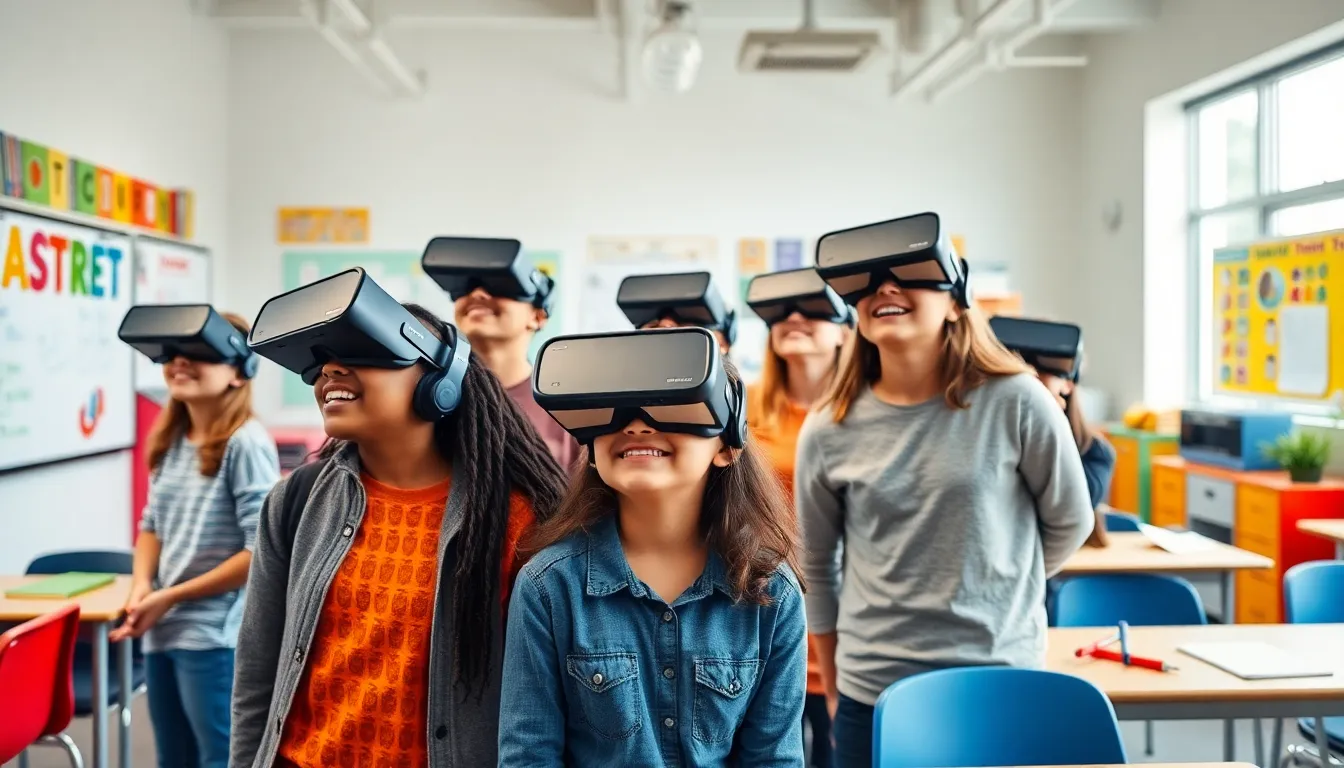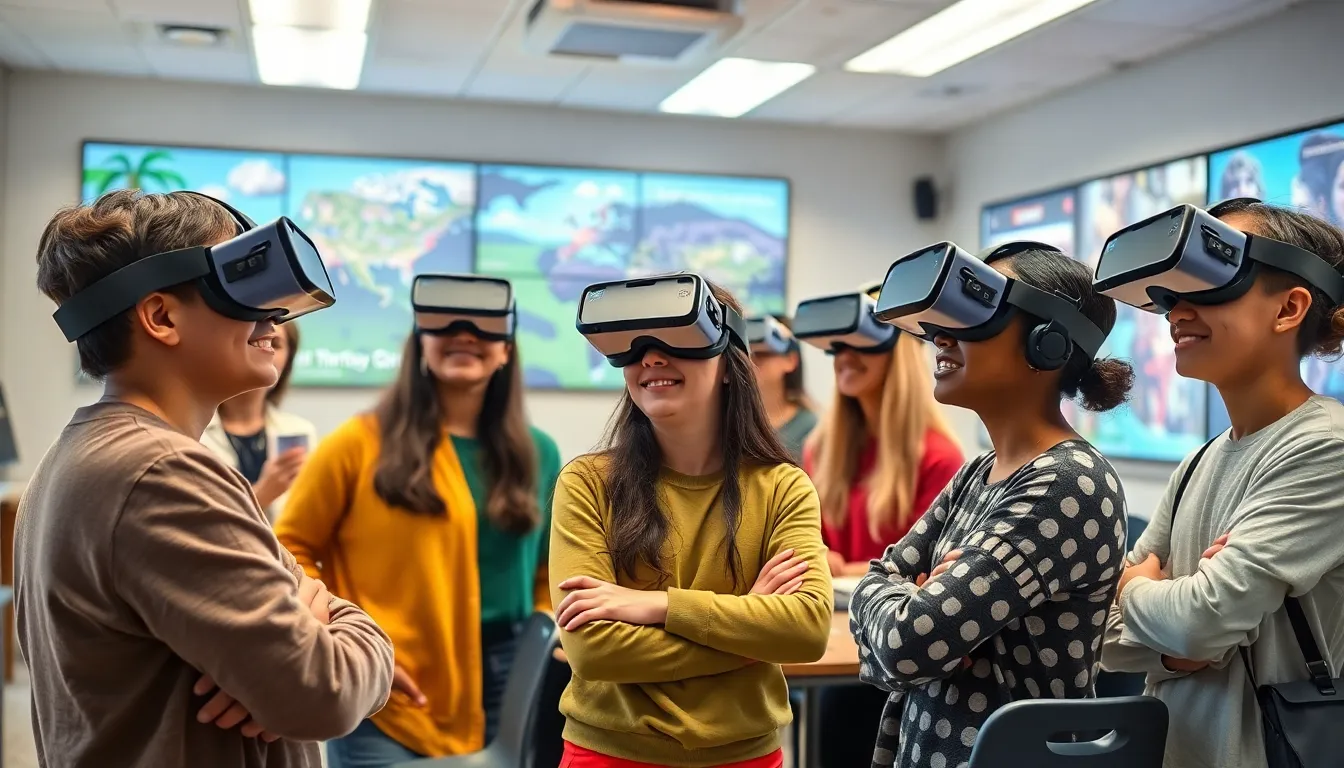Imagine stepping into a classroom where textbooks are replaced by immersive worlds, and lessons come alive in ways you never thought possible. Welcome to the future of learning with VR education tools. These innovative technologies aren’t just a gimmick—they’re transforming how students engage with information, making learning not only effective but downright fun.
Table of Contents
ToggleOverview of VR Education Tools
VR education tools provide immersive learning experiences that engage students in unique ways. These platforms allow learners to explore subjects like history, science, and art through interactive simulations. Users can experience historical events or conduct virtual science experiments, providing context and retention.
Several leading tools exist in the VR education space. Oculus Quest offers an extensive library of educational applications suitable for various age groups. Google Expeditions enables virtual field trips, allowing students to visit different parts of the world without leaving the classroom. ENGAGE focuses on creating virtual environments for customizable learning experiences, appealing to both educators and students.
VR education tools enhance collaboration. Learners can work together in shared virtual spaces, fostering teamwork and communication skills. This real-time interaction helps develop social skills while engaging with challenging content. Platforms like ClassVR support group activities, promoting collective learning.
Data support the effectiveness of VR tools in improving learning outcomes. Research shows that students retain 75% of what they learn in immersive environments, compared to just 10% from traditional lectures. Such statistics highlight the lasting impact that these tools can have on knowledge retention.
Inclusion of VR education tools in curricula can promote motivation and engagement among students. Innovative experiences inspire curiosity and inquiry, encouraging learners to explore beyond conventional boundaries. With advancements in technology, these tools will continue to evolve, shaping the future of education.
Benefits of VR Education Tools

VR education tools offer significant advantages for both students and educators. These technologies captivate learners, creating a dynamic educational landscape that enhances the overall learning experience.
Enhanced Engagement
VR education tools captivate students’ attention in ways traditional methods cannot. Immersive environments transport learners into their subject matter, making them active participants rather than passive observers. Interactive simulations engage students with real-world applications, heightening their curiosity and motivation. According to studies, students exhibit increased enthusiasm and participation during VR activities. Educators report that this heightened engagement encourages more profound exploration of topics, contributing to a richer learning environment.
Improved Retention
VR education tools significantly impact knowledge retention. Research shows students retain 75% of information learned in immersive settings, compared to just 10% in traditional lectures. This difference stems from the interactive nature of VR experiences, which foster emotional connections to the material. By placing learners in realistic scenarios, these tools enhance critical thinking and problem-solving skills. As a result, students recall information more effectively and demonstrate improved performance in assessments. The use of VR in classrooms creates a memorable educational experience that leaves a lasting impression.
Types of VR Education Tools
VR education tools come in various forms, enhancing the learning experience through immersive technology. They enable students to engage with subjects actively.
Virtual Classrooms
Virtual classrooms provide realistic environments where learners and instructors interact. In these spaces, students can attend lectures and participate in discussions from anywhere globally. Features like video conferencing, interactive whiteboards, and shared digital resources enrich the experience. Research shows that students in virtual classrooms demonstrate improved collaboration and communication skills. Platforms like ENGAGE offer customizable classroom settings, making tailored learning experiences possible. These tools democratize access to education, allowing students from different backgrounds to embark on a shared journey of knowledge.
Simulation-Based Learning
Simulation-based learning immerses students in practical scenarios where they apply theoretical concepts. This method enables hands-on experience in fields such as healthcare and engineering. For example, medical students can practice procedures in virtual hospitals without risk to real patients. Studies reflect that learners in simulated environments retain 75% of the material, as opposed to 10% through traditional lectures. Engaging in realistic simulations fosters critical thinking and decision-making skills essential for real-world applications. Tools like Oculus Quest facilitate these immersive experiences, making high-quality simulations accessible and effective.
Challenges in Implementing VR Education Tools
Implementing VR education tools faces several challenges that can impact their effectiveness in classrooms.
Cost Considerations
Budget constraints often hinder institutions from adopting VR education tools. Initial investment costs for hardware like VR headsets can exceed $300 per unit, while additional software licenses can raise expenses further. Schools must also account for maintenance and upgrades, as technology evolves rapidly. Limited funding in many districts restricts access to cutting-edge resources. Comparatively, traditional teaching tools may require significantly lower investment. Consequently, without financial support, schools struggle to integrate VR into their curricula effectively.
Technical Limitations
Technical limitations present significant hurdles in using VR education tools. Not all classrooms feature the necessary infrastructure, such as high-speed internet connections or sufficient space for VR activities. Some devices may offer limited battery life, restricting usage duration. Issues surrounding compatibility can arise when software doesn’t support multiple operating systems. Furthermore, teacher training often lags, leaving educators unprepared to use these tools effectively. Institutions must address these technical challenges to maximize VR’s educational potential.
Future Trends in VR Education Tools
Emerging trends shape the evolution of VR education tools. Increased accessibility drives widespread adoption. Developers integrate VR with artificial intelligence, personalizing learning experiences based on individual student needs. Enhanced collaboration features, such as multi-user environments, will promote team-based learning across classrooms.
Customizable content creation will empower educators. Teachers can generate tailored lessons suited to diverse learning styles, expanding engagement. Furthermore, improved hardware affordability makes VR tools more viable for institutions facing budget constraints. Statistics indicate that nearly 70% of schools plan to incorporate VR into their curricula by 2025.
More educational institutions recognize the necessity of immersive experiences. Research shows that experiential learning leads to improved retention rates. As tools evolve, the monitoring of student progress through analytics will refine educational outcomes. Key performance indicators can measure student engagement, motivation, and overall achievement in real-time.
Professional development for educators remains important. Training programs focused on VR integration enhance teachers’ skills, ensuring effective implementation. Collaboration between tech companies and educational providers supports this effort, fostering a shared vision for VR education.
Expanding application areas are noteworthy. Fields such as virtual reality medicine, environmental science, and historical studies see significant advancements. Students engage with content on a deeper level, facilitating critical thinking and problem-solving skills.
Overall, these trends predict a future where VR education tools become integral to learning. The fusion of technology and education creates dynamic environments, transforming how students interact with knowledge.
The future of education is undeniably intertwined with the advancements in VR technology. As immersive experiences become more accessible and affordable, educational institutions are poised to embrace these innovative tools. The potential for enhanced engagement and deeper learning is significant, offering students unique opportunities to explore complex subjects in ways that traditional methods simply can’t match.
With ongoing developments in VR education tools, collaboration among educators and tech developers will be essential. This partnership will ensure that the integration of VR into curricula not only addresses existing challenges but also maximizes its benefits. As these tools continue to evolve, they’ll redefine the educational landscape, creating a more interactive and effective learning environment for all students.




